Tokyo
![]()
This article covers the area of the 23 municipalities colloquially known collectively as the city of Tokyo. For other meanings, see Tokyo (disambiguation).
Tokyo (also Tokyo, Japanese 東京 Tōkyō [![]()
![]() to̞ːkjo̞ː]) is a global city in the Kantō region in the east of the Japanese main island of Honshū. With a population of 9,640,742, it is not only the most populous metropolis in the country, but also part of the capital area of Japan as the seat of the Japanese government and the Tennō. It comprises the 23 districts on the territory of Tokyo City, which was abolished as an administrative unit in 1943, and is thus no longer a separate territorial entity; instead, the districts, together with the cities and municipalities of the Tama region to the west and the southern Izu and Ogasawara Islands, form Tokyo Prefecture. This in turn forms the center of the Tokyo-Yokohama metropolitan region, which is home to more than 38.5 million people (as of 2019), making it the largest metropolitan area in the world.
to̞ːkjo̞ː]) is a global city in the Kantō region in the east of the Japanese main island of Honshū. With a population of 9,640,742, it is not only the most populous metropolis in the country, but also part of the capital area of Japan as the seat of the Japanese government and the Tennō. It comprises the 23 districts on the territory of Tokyo City, which was abolished as an administrative unit in 1943, and is thus no longer a separate territorial entity; instead, the districts, together with the cities and municipalities of the Tama region to the west and the southern Izu and Ogasawara Islands, form Tokyo Prefecture. This in turn forms the center of the Tokyo-Yokohama metropolitan region, which is home to more than 38.5 million people (as of 2019), making it the largest metropolitan area in the world.
The city's history begins in 1446, when Ōta Dōkan began building Edo Castle in a marshy area on the northern shore of what is now Tokyo Bay, surrounded by a few fishing villages. In 1590, this castle passed to Tokugawa Ieyasu, who established his new Shōgunate here after his victory in the Battle of Sekigahara, and thus the Edo period. Edo became the political and cultural center of the country, along with Kyōto. With the Meiji Restoration in 1868, the Shōgunate was abolished and the seat of the Tennō was moved to Edo, the castle became the imperial palace, and Edo was given its new name Tokyo, meaning "Eastern Capital." From then on, the city's population also grew, and by 1910 it was already one of the largest in the world, with a population of around two million. During World War II, Tokyo was subjected to numerous air raids by the U.S., during which about half of the city's area was destroyed. After the end of the American occupation, a rapid economic upswing followed, accompanied by a renewed increase in population.
Today, Tokyo is the industrial, commercial, educational and cultural center of Japan, with numerous universities, colleges, research institutes, theaters and museums. With Narita and Haneda airports and as the starting point of most Shinkansen lines, it is also the country's transportation center. The financial center of Tokyo is not only the largest in Japan, but is also one of the five largest in the world, along with London, New York and Hong Kong. In addition, the city has a high price level and was ranked 9th most expensive city in the world in a 2014 study. In addition to modern attractions such as the Tokyo Tower or Tokyo Skytree, it also offers historical sites such as the Imperial Gardens in Chiyoda, Ueno Park or the Asakusa Kannon Temple. In recent years, Tokyo has become an increasingly popular tourist destination and is among the top 20 most visited cities, with up to eight million visitors from abroad each year. In a 2018 ranking of cities by quality of life, Tokyo ranked 50th among 231 cities surveyed worldwide.
Geography
Geographical position
Tokyo is located on Tokyo Bay on the island of Honshū, the largest of the four main islands of the Japanese archipelago, in the Kantō Plain (Kantō-heiya) an average of six meters above sea level. Kantō is the area that lies in a wide arc around Tokyo Bay. The name Kantō means "east of the barrier"-a historical designation. (Kansai, meaning "west of the barrier," is the area around Osaka.) By "barrier" is meant the old customs border that separated western Japan from eastern Japan, west of the city of Hakone.
The Kantō Plain is the largest plain in Japan. Earlier, violent volcanic eruptions of Fujisan, which has been rather quiet in recent centuries, covered almost the entire plain with fertile volcanic ash - the so-called kantō rōmu sō. In addition, there is the large Tokio Bay, which is deep enough to function as a harbor and shallow enough to wrest larger areas from the sea.
Definition and size of Tokyo
In the administrative sense, there is no city of Tokyo. The urban area in the sense of this article are the 23 districts of Tokyo. Their area is 621.98 square kilometers. They form the urban core of the metropolitan area and are located on the territory of the former city of Tokyo, which was dissolved as a political entity in 1943. Each district (jap. 区 ku) is administratively an independent municipality. Officially, the districts refer to themselves in English as City (e.g. Shinjuku City, Shibuya City).
Tokyo Prefecture (Jap. 東京都 Tōkyō-to; English: Tokyo Metropolis) includes the 23 districts as well as the western part of the metropolitan area, up to the foothills of the Japanese Alps, the Tama region. In addition, the prefecture includes the Izu Islands and Ogasawara Islands, located south in the Pacific Ocean, as well as Okinotorishima. The prefecture has over 13 million inhabitants and extends to the Tropic of Cancer.
Although Tokyo (in terms of the 23 districts) alone is already home to over nine million inhabitants, the city itself is surrounded by cities with millions of inhabitants, Saitama in the north, Chiba in the east, and Yokohama and Kawasaki (Kanagawa Prefecture) in the south. To the west is the Tama region with a population of four million.
Together, these cities and their surrounding areas form the Tokyo metropolitan area. In Japan, the area is referred to as the Tokyo area (東京圏, Tōkyō-ken), the capital area (首都圏, Shuto-ken), or the southern Kantō (南関東, Minami-Kantō). The different names denote different definitions for the boundaries of the metropolitan region, which generally includes Tokyo Prefecture itself, though excluding Pacific islands, and completely or partially includes the neighboring prefectures of Chiba, Kanagawa, and Saitama, as well as smaller parts of Gunma, Ibaraki, and Tochigi, and even Yamanashi. The metropolitan area covers 13,572 km² and has a population of about 37.555 million (2014). The metropolitan area around Tokyo forms the largest metropolitan region in the world.
The 23 districts of Tokyo
The area of the former city of Tokyo with its 35 boroughs, i.e. the urban core of Tokyo, has been filled since 1947 by the 23 districts (区 -ku), which largely function as independent municipalities:
- Adachi
- Arakawa
- Bunkyō
- Chiyoda
- Chūō
- Edogawa
- Itabashi
- Katsushika
- Kita
- Kōtō
- Meguro
- Minato
- Nakano
- Nerima
- Ōta
- Setagaya
- Shibuya
- Shinagawa
- Shinjuku
- Suginami
- Sumida
- Toshima
- Taitō
Climate
The city is located in the area of subtropical east side climate (according to Neef). According to Köppen's climate classification, the city belongs to the warm temperate maritime climate. Summers are hot and humid (30 °C during the day and 20 °C at night), winters are dry and sunny (10 °C during the day and around 0 °C at night); sometimes snow falls. The rainy season (Tsuyu), with daily rain showers, lasts from late June to mid-July. It is caused by humid trade winds from the western Pacific. Afterwards - from mid-July to the end of August - it is persistently hot with high humidity.
Typhoons threaten in September or October, but rarely last more than a day. They usually form in the summer or early fall in the North Pacific west of the International Date Line and north of latitude 5° N at the edge of the caldera belt, and then usually first travel northwest toward Vietnam, the Philippines, and China. If they do not reach the mainland, they turn northeast and strike Korea and Japan. In Tokyo, typhoons bring strong gusts of wind and rain, but then gradually weaken as they move inland, as they no longer absorb water.
The average annual temperature in Tokyo is 15.6 °C, and the average annual precipitation is 1466.8 millimeters. The warmest month is August with an average of 27.1 °C, the coldest is January with an average of 5.2 °C. The most precipitation falls in September with an average of 208.5 millimeters, the least in December with an average of 39.6 millimeters.
| Tokyo | ||||||||||||||||||||||||||||||||||||||||||||||||
| Climate diagram | ||||||||||||||||||||||||||||||||||||||||||||||||
| ||||||||||||||||||||||||||||||||||||||||||||||||
| Monthly average temperatures and precipitation for Tokyo
Source: Japan Meteorological Agency; wetterkontor.de | ||||||||||||||||||||||||||||||||||||||||||||||||||||||||||||||||||||||||||||||||||||||||||||||||||||||||||||||||||||||||||||||||||||||||||||||||||||||||||||||||||||||||||||||||||||||||||||||||||||||||||||||||||||||||||||||||||||||||||||||||||||||||||||||||||||||||||||||||||||||||||
Earthquake
→ Main article: Tokyo earthquake
Tokyo is located in one of the most active earthquake zones in the world. Small earthquakes are nothing unusual in the city. During the very active phases, small, noticeable earthquakes can occur almost daily. Despite all efforts, scientists have not yet succeeded in effective earthquake prediction.
One of the best-known theories comes from Kawasumi Hiroshi, the president of the Institute of Earthquake Research at the University of Tokyo. He has analyzed all earthquakes in Tokyo since the year 818 with a magnitude of more than 5 on the Richter scale and found that a major earthquake occurs on average every 69 years. According to this, the next major quake should have come in 1992. However, this is a purely statistical calculation that does not take into account any geological conditions and is therefore completely unsuitable for short-term prediction. Ishibashi Katsuhiko of Kōbe University took a considerably more differentiated view. According to him, earthquakes always occur in a certain cycle. At the beginning, there are several smaller quakes; a large quake then always forms the conclusion of this cycle.
One of the most severe earthquakes was the Great Kantō Earthquake with a magnitude of 7.9, which killed about 140,000 people and destroyed about 380,000 houses in Tokyo and Yokohama on September 1, 1923. Other major quakes occurred in 1615 (magnitude 6.4), 1649 (7.1), 1703 (8.2), 1855 (6.9) and 1894 (7.0). In the Genroku earthquake on December 31, 1703, Tokyo (then Edo) and other cities in the area were destroyed. Over 10,000 people lost their lives in the region.
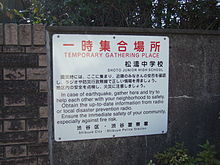
Earthquake case collection area in Shibuya, Tokyo.

Landsat image of Tokyo and its surroundings
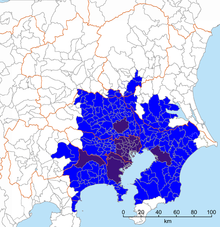
Kantō metropolitan region ( 関東大都市圏, Kantō Dai-toshi-ken; population 37.555 million, 2014).
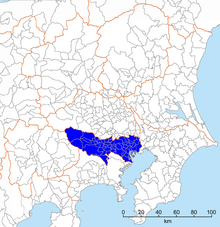
Map of Tokyo Prefecture with the 23 districts and Tama region, excluding Pacific Islands.
History
Origin
As archaeological findings prove, the city area was already populated in the Stone Age. Originally, Tokyo was a small fishing port under its former name Edo. Around the year 1457, the then Daimyō Ōta Dōkan had a castle built near the village. The settlement did not gain importance until 1590, when it became the property of Shōgun Tokugawa Ieyasu (1543-1616).
Edo period
→ Main article: Edo
Tokugawa Ieyasu designated Edo as the capital of the Shōgunate, the true power in Japan, in 1603, while the powerless Tennō (emperor) continued to reside in the official capital of Kyōto. Edo Castle was restored and expanded during his reign. The area around the Edo Castle was known as Yamanote.
Tokyo was frequently hit by devastating earthquakes and major fires. In 1657, for example, a major fire claimed several thousand lives and destroyed more than 60 percent of the city's area at the time. The Shōgunat took this opportunity to reorganize the city's structures, mainly to prevent fires and strengthen the defenses of the Edo Castle. During this phase, shrines and temples were systematically transported to outlying districts and city residents were relocated to newly built outlying districts.
The city's more rapid growth was brought about by Tokugawa Ieyasu's order to his daimyō to build their own residences in Edo, where their families were effectively held hostage (Sankin-kōtai decree). Numerous craftsmen and merchants needed to supply the court settled in Edo in the early 18th century.

enlarge and show information about the image
![]()
Panorama of Edo 1865/66 (montage of photochrome prints from five albumen photographs by Felice Beato)
Meiji period until the Second World War
→ Main article: Tokyo (city)
In 1868, at the instigation of the Meiji-Tennō (Mutsuhito, 1852-1912), the imperial court was moved to Edo and the city was renamed 東京 for "eastern capital" or, more precisely, "imperial residence city in the east." The characters at that time were read partly in the Han phonetic Tōkei, and partly already in the Wu phonetic Tōkyō (Tokyo).
In 1872, a major fire destroyed the Ginza and Marunouchi districts. The reconstruction and the associated modernization of the cityscape were based on Western models. The planning for this was entrusted to an English architect who wanted to shape the cityscape with a mixture of European styles (Parisian streets and London-style houses). Despite a certain ambivalence among the population about the completely new, Western buildings, which conveyed a more cohesive residential feeling, the governor of Tokyo Prefecture at the time, Yuri Kimimasa, had craftsmen and builders come to Tokyo to begin work. In the Ginza district in particular, reconstruction was to begin as soon as possible, as a rail line between Yokohama and Shimbashi was to be inaugurated there. By moving traditional residential and warehouse buildings to side streets, space was made for the new architecture.
The worst natural disaster in Tokyo's recent history was the Great Kantō Earthquake and Fire of September 1, 1923, which destroyed much of the city. Reconstruction, which ended in 1930, saw the construction of over 200,000 new buildings, including many of Western design, as well as seven reinforced concrete bridges over the Sumida River and several parks.
In 1943, the Tōkyō-tosei decree dissolved the city of Tokyo as an administrative unit. During World War II, the United States began bombing Tokyo on November 24, 1944, and American bombers also flew heavy air raids on February 25 and March 10, 1945. More than 100,000 people died as entire neighborhoods of buildings of traditional wooden construction fell to the flames. All houses were destroyed over an area of 15 square miles, and the historic Imperial Palace was also destroyed.
Postwar period until today
During the occupation, Tokyo was occupied by American troops from September 1945 to April 1952. Across the street from the Imperial Palace resided General Douglas MacArthur, who headed the occupation authorities as Supreme Commander for the Allied Powers. Especially from the beginning of the Korean War, the city experienced a phase of rapid reconstruction and economic growth.
From October 10 to October 24, 1964, the XVIII Summer Olympic Games were held in Tokyo.
On March 20, 1995, members of the Ōmu Shinrikyō (Aum sect) carried out a sarin attack on the Tokyo subway. Thirteen people died and 6,252 were injured.
According to the 2009 Forbes list of World's Most Expensive Cities To Live, Tokyo is considered the most expensive city in the world. In March 2013, the Forbes list named Tokyo second (behind Hong Kong).
On September 7, 2013, Tokyo was selected by the International Olympic Committee (IOC) to host the 2020 Summer Olympics, which had to be postponed to 2021 due to the COVID-19 pandemic.
Outlook for the future
For the near future, seismologists predict a devastating earthquake for Tokyo on the scale of the Great Kantō Earthquake of 1923. This and the exorbitant land prices are the reasons why a relocation of the capital away from Tokyo has been discussed and planned since the 1990s - there have been many relocations of the capital for religious and political reasons in Japanese history. Based on a 1992 law, three candidate regions were identified by 1999: Tochigi-Fukushima in the northeast, Gifu-Aichi in Tōkai, and Mie-Kiō. So far, no activities have taken place.
Population development
Since the 1880s, Tokyo has been home to more than one million residents. Since the late 1940s, the Tokyo metropolitan area has again grown rapidly, both in terms of area and population. It is home to about a quarter of Japan's total population. Its outer boundary is between 40 and 70 kilometers from the city center. After an interim peak in 1965, the population of the 23 districts had declined, but is currently rising again due to reurbanization and has now also surpassed the 1965 level.
The 23 districts have a combined population of 9,640,742 (as of March 1, 2021). Together with the adjacent prefectures of Kanagawa, Saitama, and Chiba, the Tokyo metropolitan area forms the largest contiguous urban area on earth with a population of 37.4 million (2017). The metropolitan region is home to 27 cities with populations of more than 200,000, 17 cities with populations of more than 300,000, and eight with populations of more than 500,000.
Tokyo has three other megacities as suburbs: Yokohama, Saitama and Kawasaki. About 900,000 people live in the eastern suburb of Chiba. Yokohama in the south of Tokyo has 3.6 million inhabitants, about as many as Berlin or Madrid.
The following overview shows the population figures of the former city of Tokyo, i.e. the area of today's 23 districts, according to the respective territorial status. Up to 1914, these are estimates; from 1920 to 2005, they are census results.
|
|
|
Population development of the metropolitan region
According to United Nations figures, the metropolitan region's population grew from 11.3 million in 1950 to over 37.4 million in 2017. This makes the Tokyo metropolitan region the largest in the world. The population is still expected to increase through 2020. A population of 32.6 million is projected for 2050, which would mean that Tokyo would lose its status as the world's most populous agglomeration. For 2100, the population is expected to be 25.6 million.
Population development of the agglomeration according to UN
| Year | Population |
| 1950 | 11.275.000 |
| 1960 | 16.679.000 |
| 1970 | 23.298.000 |
| 1980 | 28.549.000 |
| 1990 | 32.530.000 |
| 2000 | 34.450.000 |
| 2010 | 36.860.000 |
| 2017 | 37.397.000 |
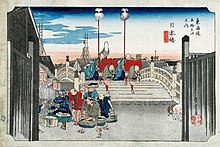
Nihonbashi in Edo, woodblock print by Hiroshige, 1832
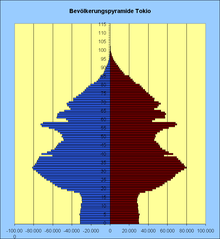
Tokyo population pyramid. With an average fertility rate of 0.98 (2006), Tokyo is one of the cities with the lowest number of children in all of Japan. The lowest rate is in Shibuya with 0.73, the highest in Edogawa with 1.33. (cf. Germany 1.33; Berlin 1.22).
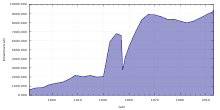
Population development of Tokyo between 1870 and present
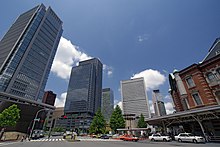
Marunouchi

Shibuya intersection
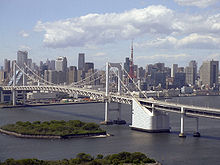
Rainbow Bridge in Tokyo
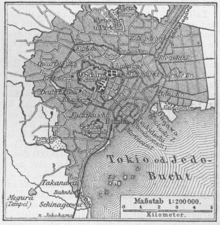
Historical map of Tokyo from 1888
Questions and Answers
Q: What is Tokyo?
A: Tokyo is the capital and largest city of Japan located on the island of Honshu in the region of Kanto.
Q: What is the Imperial Palace?
A: The Imperial Palace is in Tokyo and it's not actually public for tourists.
Q: What is the center of business, trade, and industry of Japan?
A: Tokyo is the center of business, trade, and industry of Japan.
Q: Where is Tokyo located?
A: Tokyo is located on the island of Honshu in the region of Kanto in Japan.
Q: What was the capital city of Japan before Tokyo?
A: Kyoto was the capital city of Japan before Tokyo.
Q: Why did the name of Edo change to Tokyo?
A: The name of Edo changed to Tokyo in the middle of the 19th century when it became the capital city of Japan.
Q: What happened to Tokyo during World War II?
A: Tokyo was badly damaged by bombs during World War II and after Japan lost the war, the city was rebuilt.
Search within the encyclopedia